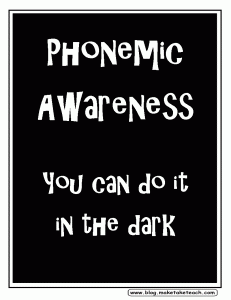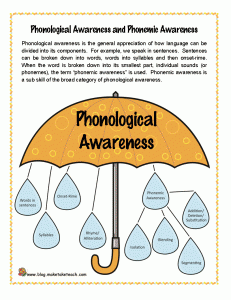Several years back all the K-6 and special education teachers in our districts participated in the Language Essentials for Teachers of Language and Spelling (LETRS) training. One of the beginning sessions introduced the the five key areas of reading instruction proposed by the National Reading Panel. Phonemic awareness and phonics are two of these components. During this session, there seemed to be quite a bit of confusion over the terms of “phonological awareness”, “phonemic awareness” and “phonics” and knowing the difference between those terms. So, let me see if I can help provide clarification.
Phonological Awareness- Phonological awareness is a general appreciation of how spoken language can be divided into its components. For example, we speak in sentences. Sentences can be broken down into words and words into syllables. Breaking words into onset-rime and an appreciation of rhyme and alliteration fall under the category of phonological awareness.
Phonemic Awareness- The word “phoneme” means sound. When a word is broken down into its smallest unit, a sound (or phoneme), the term “phonemic awareness” is used. Phonemic awareness is a sub skill of the broad category of phonological awareness. Phoneme isolation, blending, and segmenting are several skills that fall under this category.
Maybe this graphic helps.
Click the following link to download the above graphic: Phonological Awareness
Phonics and phonemic awareness are not the same. Phonics involves how speech sounds correspond to the written letter or letter combinations. Phonemic awareness is only about hearing and manipulating the individual speech sounds in words. The best way to remember the difference between these two terms is to know that any phonemic awareness skills can be “done in the dark”.
 To download the “Do It In the Dark” poster click the following link: Phonemic Awareness Do It In the Dark
To download the “Do It In the Dark” poster click the following link: Phonemic Awareness Do It In the Dark
Did you know– Research has identified phonemic awareness and letter knowledge as the two best predictors of how well a child will learn to read during the first two years of school.



